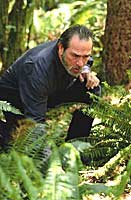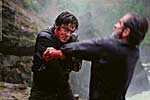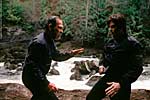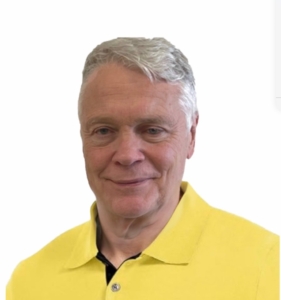The Hunted
Review by Christopher Caile
Editor's Note: FightingArts.com was invited to preview this film and interview one of its primary actors, Oscar winner Benicio Del Toro, as well as Tom Brown, Jr., who not only was an inspiration for the film, but acted as technical consultant.

"The Hunted" stars Oscar winners Tommy Lee Jones and Benicio Del Toro along with Connie Nielsen. The film was directed by Academy Award and Golden Globe winner Billy Friedkin. The film is rated "R."
This film seemed to be a combination remake of several films. First is "The Fugitive" that featured a chase between a wrongfully-accused prison escapee against the US Marshalls ordered to find him, headed by a character also played Tommy Lee Jones.

A camouflaged Hallam (Del Toro), a crazed Ninja-like killer melts through the forest
This plot is combined with the ex-Green Beret protagonist with a featured knife as seen in "Rambo," who wages a one-man guerrilla war in the mountains. But in this movie the Rambo-type figure is no hero – he has dropped over the mental edge into his own haunted hell to become a demented killer.
 |
Master tracker L.T. Bonham (Jones) tracks his prodigy |
The movie's plot is potentially a good one. It is about a wilderness tracker and retired Special Forces trainer, L.T. Bonham (Jones), who teams up with the FBI, headed by special agent Abby Durrell (Connie Nielsen), to hunt down the perpetrator of a series of grisly murders of hunters in the Pacific Northwest. Jones soon recognizes signs that the killer is a former student, a military special operation's killer, Aaron Hallam, enigmatically portrayed by Del Toro.
Both main characters are internally tormented. Bonham (Jones) is driven by guilt over having trained military special-operations assassins, and Aaron Hallam's (Del Toro) mind has been warped by the bloody butchery he experienced. Early in the film, the Jones character, while teaching Special Forces how to kill, says that once the mind can accept killing, the physical part is easy. What's not easy is turning it off. Del Toro's mind can't turn it off.
The film opens in 1999 with Hallam (Del Toro), Jones' student, on a secret behind-the-lines operation during the bloodiest fighting in Kosovo. It's night. Buildings lay in ruins. Fire, explosions, bombing from American bombs and constant gun fire on the ground are all around. Against this fiery background Serbian soldiers are carrying out atrocities against Albanian civilians. It's a blood bath. Del Toro silently slips through this carnage, past guards, into a make-shift headquarters building to assassinate the Serbian officers who had ordered the butchery.
Hallam (Del Toro) is tormented by these memories. There are incessant nightmares, and he goes AWOL. In some demented way he reverts to a path that parallels his former teacher. Bonham (Jones) has become an agent for the charitable WildLife Fund. Hallam too escapes into the wilderness and becomes a protector of wildlife in his own way: he resents hi-tech hunters and begins to hunt them down using only his senses, camouflage and a knife – a knife that becomes a secondary character in the film. His training assists him. He can magically disappear into the forest, almost before one's very eyes, and then appear suddenly in violence.
Hallam's brutal killings prompt the FBI to hire Bonham, who is uniquely equipped to track and find this type of elusive killer. He is convinced by gruesome pictures of the crime scene to come out of retirement. Once on the scene, Bonham heads into the woods alone and soon recognizes clues that point to his own protégé as the killer. Bonham then begins to track Hallam alone across countryside and forests, both men using their survival and tracking skills as Hallam constructs elaborate booby traps to stop him.
Bonham's (Jones) tracking is phenomenal, expertise reminiscent of that portrayed in the film "Butch Cassidy and the Sundance Kid." After capture, Del Toro's character makes an escape, the action moving to an urban environment. The chase includes thrilling action, such as a spectacular stunt from Portland's interstate Bridge into the waters of the Williamette River below. The fast-paced action leads toward a climactic, bloody knife battle from which only one will emerge.
William Friedkin, the film's director, was inspired to make the movie after befriending Tom Brown, Jr., a wilderness tracker and survivalist who trained Delta Force and Navy Seal forces. He taught real world, Ninja-type expertise on how to use the environment, camouflage, and make way through enemy territory invisibly and without a sound, like a shadow, to be aware of danger and how to avoid it. The knife featured in the film was Brown's too, especially developed by him for wilderness survival and now produced by a major knife manufacturer.
Friedkin says, "I was fascinated with the nature of the man (Brown) who has these skills – he's able to survive and kill – but he's never really used those skills in combat."
Then Friedkin read a script by David and Peter Griffiths about a Delta Force style assassin who became a serial killer. A film script was then developed. Tom Brown was recruited to train the actors. Knife specialists and Navy Seal trainers Thomas Kier and Rafael Kayanan also worked as advisors to the film. Mark Stefanch, of Navy Seal Team 6, taught Jones and Del Toro other aspects of military combat.
So far so good, but the film breaks down in its production. Friedkin is known for exploring heroes divided against themselves, such as in "The Exorcist" and "The French Connection." But in this film Friedkin seems himself divided. On one hand the film was inspired by Tom Brown and his remarkable survivalist and tracking skills. It provides a novel twist and much of the film's publicity features this aspect. Within the film, however, it's as if Friedkin or his screen writers lost nerve, for the action soon reverts from a wilderness setting to the urban chase, mayhem, action, stunts and hand-to-hand combat.
The whole set up of the Hallam (Del Toro) character is thus wasted, along with the tracker, survivalist theme. It was limited to the first half hour of the film. The film could have been so much more. It should have focused on aspects of survival, camouflage, tracking and counter-tracking across the wilderness — the hunter against the hunted where senses, instinct and training are pitted against each other – using the same test of nerves, action, and tension that supported "The Fugitive." But it didn't happen. Yes, we see Del Toro in camouflage, melting into the background. We see his ability to appear and attack as if from nowhere. But these take second seat in the overall action, almost cameo in character.
Missing in action, too, was any depth of character development or exploration of the inner conflict that drove both Bonham (Jones) and Hallam (Del Toro). Friedkin tries to set this up in the introduction to the movie and visually by presenting both characters independently of each other in three non-verbal scenes. Their long term bond is sought to be established with a single sentence: "Hey, L.T. (Bonham)." This doesn't work. The characters and relationships are never developed, so the audience can not fully identify with them.
There is great visual imagery, but interplay of dialogue and personality is wanting. With so little to sustain the film, perhaps this is the reason that the action quickly moves to an urban environment, where stunts, car chases and hand-to hand combat become primary. Time after time Harram gets cornered but he continues to escape in stunt get-aways that strain credulity.



The film must be complimented, however, for its realistic betrayal of hand-to hand knife combat. The film does not use the typical Hollywood stunts with flashy action. Instead Bonham (Jones) and Hallam (Del Toro) use pragmatic Philippino knife fighting (Kali) skills — knife thrusts, parries and slices combined with grappling and body off-balancing. It is upfront, close-in and brutal. Everyone bleeds.
Visually this is very powerful, but the person next to me viewing the film actually hid from much of the action. She said afterwards, "I just couldn't look at that much violence."
The realism that Friedkin so relentlessly brings to the military, FBI agent and knife-fighting scenes seems to be forgotten in the rest of the film. Some of the wilderness traps set for Jones, for example, are unrealistic, as they would take too much time to build. In the urban concrete environment, the ability of Del Toro's character to vanish also becomes more difficult to believe. Likewise, his finding time to forge a new knife weapon out of rusted abandoned steel in the midst of his urban pursuit begs reality. Would Bonham ever have been unarmed?
No doubt many viewers will forgive these lapses for the fast-paced action, stunts and thrilling chase. And like the real life action the move portrays, the film's images, once seen, are hard to get out of your head.
About the Author Christopher Caile

Screenshot
Christopher Caile is the Founder and Editor-In-Chief of FightingArts.com. He has been a student of the martial arts for over 65 years.
He first started in judo while in college. Then he added karate as a student of Phil Koeppel in 1959 studying Kempo and Wado-Ryu karate. He later added Shotokan Karate where he was promoted to brown belt and taught beginner classes. In 1960 while living in Finland, Caile introduced karate to that country and placed fourth in that nation's first national judo tournament.
Wanting to further his karate studies, Caile then hitch hiked from Finland to Japan traveling through Scandinavia, Europe, North Africa, the Middle East and South and Southeast Asia — living on 25 cents a day and often sleeping outside.
Arriving in Japan (1962), Caile was introduced to Mas Oyama and his fledgling full contact Kyokushinkai Karate by Donn Draeger, the famous martial artist and historian. Donn also housed him with several other senior international judo practitioners. Donn became Caile's martial arts mentor, coaching him in judo and introducing him to Shinto Muso-ryu under Takaji Shimizu.
Caile studied at Oyama's honbu dojo and also at Kenji Kurosaki's second Tokyo Kyokushinkai dojo. In his first day in class Oyama asked Caile to teach English to his chief instructor, Tadashi Nakamura. They have been friends ever since. Caile also participated in Oyama's masterwork book, "This Is Karate."
Caile left Japan with his black belt and designation as Branch Chief, the first in the US to have had extensive training in Japan directly under Oyama Sensei. As such, Oyama Sensei asked him to be his representative on visits to his US dojos to report on their status.
A little over a year later, Nakamura, Kusosaki and Akio Fujihira won an epic David vs. Goliath challenge match against Thailand's professional Muay Thai Boxers in Bangkok, Thailand, thrusting Kyolushinkai and Nakamura into national prominence.
Back in the US Caile taught Kyokushinkai karate in Peoria, Il while in college and later in Washington, DC. while in graduate school. Durimg this time Shihan Nakamura had moved to New York City to head Kyokushinkai's North American Operation.
In 1976 when Kaicho Tadashi Nakamura formed the World Seido Karate organization, Caile followed. Living then in Buffalo, NY, Caile taught Seido karate and self-defense at the State University of New York at Buffalo (SUNY Buffalo) for over 15 years where he also frequently lectured on martial arts and Zen in courses on Japanese culture.
Caile moved to New York City in 1999 to marry Jackie Veit. He is now an 8th degree black belt, Hanshi, training in Seido Karate's Westchester, NY Johshin Honzan (Spiritual Center) dojo. In Seido Caile is known for his teaching of and seminars on kata applications. He also produced a 14 segment video series on Pinan kata Bunkai currently available to Seido members.
Caile is also a long-time student and Shihan in Aikido. He studied in Buffalo, under Mike Hawley Shihan, and then under Wadokai Aikido's founder, the late Roy Suenaka (uchi deshi under Morihei Ueshiba, founder of Aikido and was Shihan under Tohei Sensei). In karate, Suenaka (8thdan) was also an in-house student of the Okinawan karate master Hohan Soken.
Having moved to New York City, Caile in 2000 founded this martial arts educational website, FightingArts.com. Twenty-five years later, in 2025, it underwent a major update and revision.
For FightingArts.com and other publications Caile wrote hundreds of articles on karate, martial arts, Japanese art, Chinese Medicine and edited a book on Zen. He also developed relationships with a cross section of leading martial arts teachers. Over the last four decades he has conducted extensive private research into karate and martial arts including private translations of the once secret Okinawan hand copied and passed on Kung Fu book, the Bubishi, as well as an early karate book by the karate master Kenwa Mabuni. He periodically returns to Japan and Okinawa to continue his studies and participate Seido karate events. In Tokyo he practiced (with Roy Suenaka Sensei) in a variety of aikido organizations with their founders – including private interviews and practices at the Aiki-kai Aikido Honbu dojo with the son and grandson of aikido's founder, Doshu (headmaster) Kisshomaru (an old uchi-deshi friend) and his son, Moriteru Ueshiba and in Iwama with Morihiro Saito. On Okinawa he studied Goju Ryu karate under Eiichi Miyazato, 10th dan founder of Naha's Jundokan, and also with Yoshitaka Taira (who later formed his own organization, who specialized in kata Bunkai. While there Caile also trained with Hohan Soken's senior student, Master Fusei Kise, 10 dan as well as with the grandson of the legendary karate master Anko Itosu.
Caile's other martial arts experience includes: Diato-ryu Aikijujitsu and Kenjitsu, kobudo, boxing, Muay Thai, MMA, Kali (empty hand, knife and bolo), study of old Okinawan Shoran-ryu & Tomari body mechanics, study of old Okinawan kata under Richard Kim, study of close quarter defense and combat, including knife and gun defenses, Kyusho Jitsu and several Chinese fighting arts including 8 Star Praying Mantis, Pak Mei (White Eyebrow), and a private family system of Kung Fu.
Caile is also a student of Zen as well as a long-term student of one branch of Traditional Chinese Medicine, Chi Kung (Qigong). As one of two senior disciples of Chi Kung master Dr. Shen (M.D., Ph.D.) Caile was certified to teach and practice. This led to Caile's founding of the The Chi Kung Healing Institute on Grand Island, NY. In Western NY, he also frequently held Chi Kung seminars, including at SUNY Buffalo and at the famous Chautauqua Institution in Chautauqua, NY. His articles on Chi Kung also appeared in the Holistic Health Journal and in several books on alternative medicine.
Caile holds a BA in International Studies from Bradley University and MA in International Relations with a specialty in South and Southeast Asia from American University in Washington, D.C. While in Buffalo, NY he also studied digital and analog electronics.
In his professional life Caile also worked in public relations and as a newspaper reporter and photographer. Earlier he worked in the field of telecommunications including Managing a Buffalo, NY sales and service branch for ITT. He then founded his own private telephone company. This was followed by creation of an electrical engineering company that designed and patented his concept for a new type of low-cost small business telephone system (which was eventually sold to Bell South). The company also did contract work for Kodak and the US space program. Simultaneously Caile designed and manufactured a unique break-apart portable pontoon boat.
Most recently Caile co-founded an internet software company. Its products include software suites with AI capability for control and management of streaming media, such as video and music, an all-in-one book publishing software product for hardcover, eBook and audio book creation and security software for buildings and government use.
For more details about Christopher Caile's martial arts, work experience and life profile, see the About section in the footer of this site.
Search for more articles by this author:






